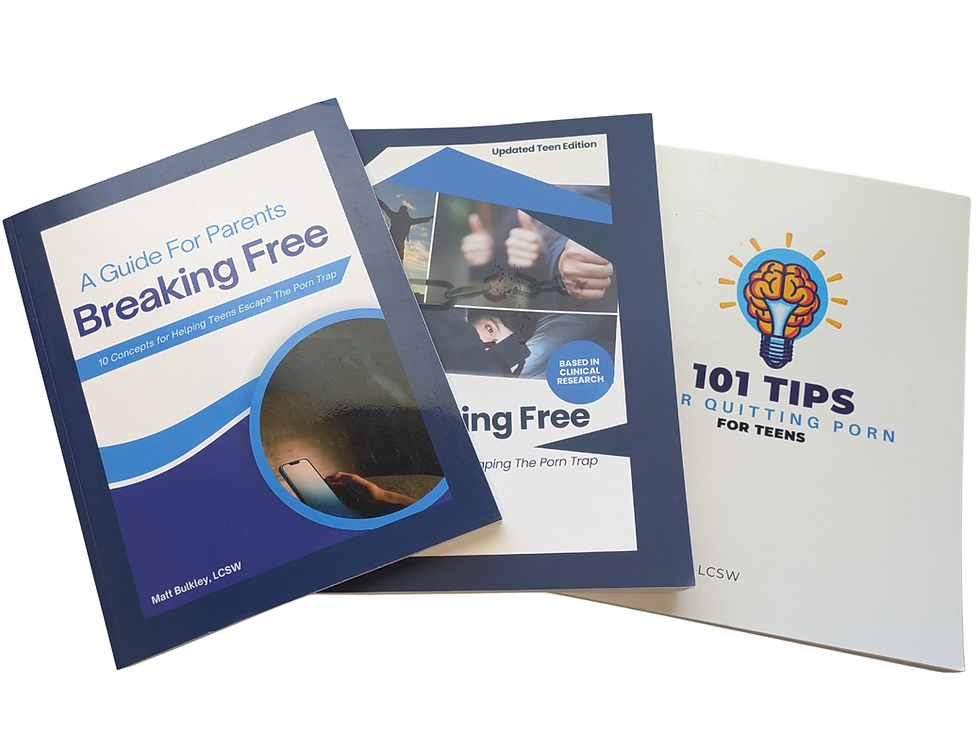Understanding Pornography’s Evolution and Its Impact on Your Teen’s Developing Brain 🧠
- Matt Bulkley

- Aug 18
- 3 min read
Discovering that your teen may be struggling with pornography can feel overwhelming. You're not alone in this challenge. Understanding how pornography has evolved and its effects on the adolescent brain can empower you to support your teen effectively. This blog post explores the transformation of pornography, its impact on developing minds, and practical steps you can take to guide your teen toward healthier habits.
The Evolution of Pornography: From Niche to Ubiquitous
Pornography is not a new phenomenon, but its accessibility and influence have changed dramatically in the digital age, making it a pressing concern for parents today.
Historical Context: For centuries, pornography was a niche product—think engravings or "blue movies" shown in private theaters. In the 1970s, films like Deep Throat briefly brought pornography into mainstream culture, but access remained limited and often stigmatized.
The VHS Era: The 1980s introduced videocassettes, allowing pornography to move from theaters into homes, increasing privacy but still requiring effort to obtain.
The Internet Revolution: The game-changer came with high-speed internet and "tube sites" in the 2000s. Suddenly, pornography became free, anonymous, and available 24/7 with just a click. This unprecedented accessibility, often described as the "three A's" (affordable, accessible, anonymous), has made pornography a pervasive part of modern life.
Why the Adolescent Brain Is Vulnerable
The teenage years are a critical period for brain development, particularly in the prefrontal cortex, which governs impulse control, decision-making, and emotional regulation. Exposure to pornography during this time can have profound effects.
Dopamine and Addiction Risk: Pornography triggers the brain's reward system, flooding it with dopamine, the "feel-good" neurotransmitter linked to pleasure. In teens, the dopamine system is naturally more active, amplifying the rush they experience. This can make pornography feel intensely rewarding, increasing the risk of compulsive use or addiction, similar to patterns seen with substances like drugs or alcohol.
Distorted Views of Sex and Relationships: Mainstream pornography often portrays unrealistic scenarios and skewed gender dynamics. For teens, who are still forming their understanding of intimacy, frequent exposure can lead to:
Unrealistic expectations about sex and relationships.
Objectification of others, particularly women.
Lowered self-esteem or body image issues.
Changes in Brain Structure: Research suggests that heavy pornography use can alter the adolescent brain. These changes may include reduced gray matter in areas tied to decision-making and emotional regulation, as well as shifts in neural connectivity similar to those seen in substance addiction.
How Parents Can Help: Practical Steps
As a parent, you play a vital role in helping your teen navigate this challenge. Here are actionable steps to foster open communication and promote healthy habits.
Start the Conversation with Empathy: Approach your teen without judgment. Acknowledge that curiosity about sex is normal but explain how pornography can distort healthy perspectives. Share age-appropriate information about the brain science behind pornography’s effects to help them understand the stakes.
Set Clear Boundaries and Use Technology Wisely: Install content filters or monitoring apps on devices and establish screen-time rules. Model healthy technology use yourself—teens learn from what you do, not just what you say.
Educate About Healthy Relationships: Discuss what real, respectful relationships look like, emphasizing mutual respect, consent, and emotional connection. Encourage open-ended questions like, “What do you think makes a relationship healthy?”
Seek Professional Support if Needed: If your teen shows signs of compulsive use (e.g., neglecting responsibilities, secrecy, or distress), consider consulting a counselor or therapist specializing in adolescent addiction.
Foster Alternative Outlets: Encourage hobbies, sports, or creative activities to channel your teen’s energy and boost their self-esteem.
Resources for Parents and Teens
Recovery Toolbox for Teens-Offers research-based education and a teen-focused recovery program (Breaking Free workbook).
Therapy Associates-outpatient treatment resources for teens and families.
Star Guides-Intensive Residential Level Treatment.
You don’t have to navigate this alone. By fostering open dialogue, setting boundaries, and providing resources, you can help your teen build a healthy understanding of sexuality and relationships while strengthening your connection with them.










Comments